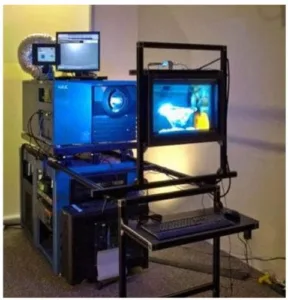There were no particular events to report this week, although Chris was away at I/ITSEC in Florida – a bit warmer than the weather here!
I was interested to see the story about the Panasonic LCD that we report on in this week’s issues (Panasonic has developed a special panel for monitors that use a dual layer approach, modulating the backlight with one LCD before the light gets to the main LCD, thus multiplying the contrast and achieving an overall contrast of 1,000,000:1). As we mention in our report, this is not the first time we’ve seen this. Back in 2005, Sharp was reported to have done something similar. Sharp also showed a 1,000,000:1 contrast LCD at a CES (if I remember correctly).
I looked back in our database (we have all the old articles in a big text database), but I couldn’t find the article I wrote after talking to Sharp at CES. The company had a 1,000,000:1 TV-sized display but would not talk about how it was done. I came up with the idea of the double LCD and asked. Staff on the booth were not prepared to confirm it (but neither did they deny it) and they did smile broadly! So, I thought I had hit the nail on the head.
At the time, there were several ideas based on multiple LCDs including displays for mission critical applications that used a transparent display on the top so that data could be moved from the front surface to one further back, to exploit the high sensitivity of the human visual system to images that seem to be getting nearer quite quickly. However, this kind of approach was expensive and tricky to do.
Clearly, as Panasonic pointed to broadcast monitors and medical monitors as the target markets for its new technology, cost remains an issue and, I suspect, power consumption as the firm highlighted that it has developed special materials that are not degraded by the very powerful backlights. (if we assume that the modulation LCD is 20% efficient, as it doesn’t have a filter, we assume, it would give an overall panel efficiency of somewhere around 1%. Given peak brightness of 1000 cd/m², that would mean 100K cd/m² at the backlight).
Of course, the idea of modulating the light source where it is separate from the imager is not new. It’s used in the dynamic irises in projectors and, of course, in LED-backlit LCDs. Dolby used an LCD to modulate a projector that it used as a high power light source for a monitor LCD when it did all its experiments in developing the PQ curve for HDR.
The Dolby HDR Apparatus used a projector as a backlight. Image:Dolby
For those of us that have been watching for a long time, the ability of LCD engineers to keep improving its performance has been phenomenal. Although OLED has clearly stepped up in the last year, it is a brave analyst that forecasts the rapid death of LCD!
Bob

